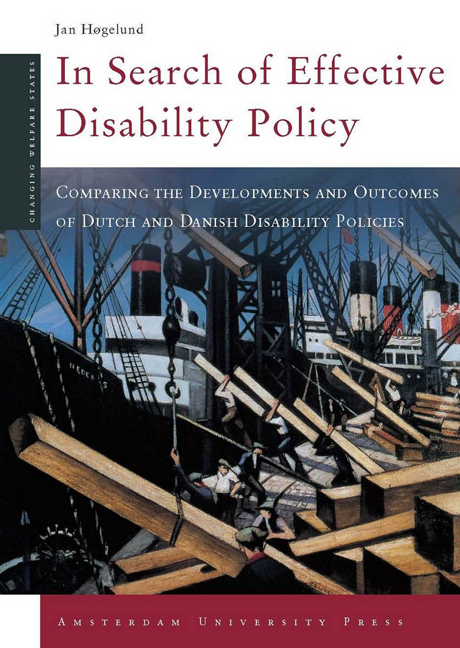 In Search of Effective Disability Policy
In Search of Effective Disability Policy Book contents
- Frontmatter
- Contents
- Acknowledgement
- 1 Disability Policies Under Pressure
- 2 The Integration of Disabled People:What Do We Know?
- 3 Bringing the Pieces Together:A Multidisciplinary Approach to Work Disability
- 4 Economic Miracles Bypassing Disabled People
- 5 Dutch Disability Reforms:Redefining Responsibilities
- 6 Danish Disability Policy:Small Steps,Big Change?
- 7 Different Routes to Integration
- 8 Different Policies – Different Outcomes
- 9 Too Much and Too Little:Employers’Responsibility in Denmark and the Netherlands
- Tables and Figures
- Notes
- References
- Index of Subjects
- Index of Names
4 - Economic Miracles Bypassing Disabled People
Published online by Cambridge University Press: 15 January 2021
- Frontmatter
- Contents
- Acknowledgement
- 1 Disability Policies Under Pressure
- 2 The Integration of Disabled People:What Do We Know?
- 3 Bringing the Pieces Together:A Multidisciplinary Approach to Work Disability
- 4 Economic Miracles Bypassing Disabled People
- 5 Dutch Disability Reforms:Redefining Responsibilities
- 6 Danish Disability Policy:Small Steps,Big Change?
- 7 Different Routes to Integration
- 8 Different Policies – Different Outcomes
- 9 Too Much and Too Little:Employers’Responsibility in Denmark and the Netherlands
- Tables and Figures
- Notes
- References
- Index of Subjects
- Index of Names
Summary
During the 1960s and 1970s the social security systems of advanced nations matured. Social insurance programmes covered more social risks and more people became eligible to still better benefits. When the economic downturn and an increasing supply of labour appeared in the 1970s and 1980s, the consequences were harsh. The number of people who temporarily or permanently left the labour market soared, and so did social security expenditure. The response to and consequences of this pressure varied across nations. This chapter uses national macro indicators to give a brief overview of the development of the Dutch and Danish welfare states over the last thirty years. Did the Netherlands and Denmark manage the economic crisis better than other European nations? To what extent were passive benefit awards and active labour market instruments used to manage the crisis? And to what extent have the Dutch and Danish ‘miracle economies’ during the 1990s succeeded in reducing the size of the disability benefit rolls?
From economic growth to crisis
During the 1960s the Netherlands and Denmark experienced like most western nations a ‘golden age’. Within the European Union nations the gdp per capita grew on average at an annual rate of 3.7 percent between 1960 and 1968, and by 4.2 percent between 1968 and 1973 (Table 4.1). During this period, the growth rates in the Netherlands and Denmark were close to the European Union average.
The growth was accompanied by record low unemployment rates, which in the Netherlands and Denmark were well below the European Union average of 2.1 percent in 1960-68 and 2.7 percent in 1968-73 (Table 4.2). However, this economic growth in the Netherlands and Denmark reflected somewhat different developments. In Denmark economic growth was obtained against the background of a high and increasing employment. During 1960 to 1967, 71.4 percent of the population aged between 15 and 64 was employed and this figure increased to 74.5 percent between 1968 and 1973. In contrast, economic growth in the Netherlands was obtained with a relatively low and decreasing employment rate, that is, 60.5 percent during 1960 to 1967 and 58.0 percent between 1968 and 1973. This crossnational difference relates to the female labour force participation.
- Type
- Chapter
- Information
- In Search of Effective Disability PolicyComparing the Developments and Outcomes of the Dutch and Danish Disability Policies, pp. 65 - 74Publisher: Amsterdam University PressPrint publication year: 2003


